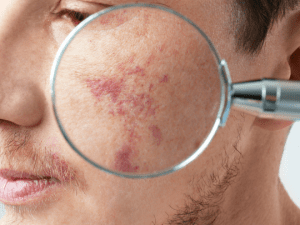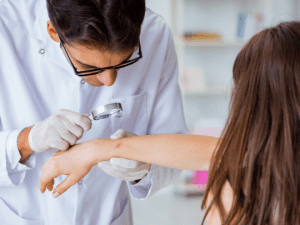What is Basal Cell Carcinoma?
Basal Cell Carcinoma (BCC) is the most common type of skin cancer in Australia and worldwide. It develops in the basal cells, which are located in the outer layer of the skin (the epidermis). While BCC is usually not life-threatening, it can cause significant damage to the skin and surrounding tissues if left untreated.
Why is BCC So Common in Australia?
Australia has one of the highest rates of skin cancer globally, largely due to:
- High UV Exposure: Australia’s sunny climate and high UV index increase the risk of skin damage.
- Outdoor Lifestyle: Many Australians enjoy outdoor activities, leading to increased sun exposure.
- Fair Skin Population: Many Australians have lighter skin types that are more prone to sunburn and UV damage.
What Causes Basal Cell Carcinoma?
The primary cause of BCC is prolonged exposure to ultraviolet (UV) radiation, mainly from:
- The Sun: Particularly during peak hours (10 am to 4 pm).
- Tanning Beds: Artificial UV radiation is also harmful.
Other Risk Factors Include:
- Having fair skin, light eyes, or red/blonde hair
- A history of frequent sunburns, especially in childhood
- Being over 50 years old
- Having a weakened immune system
- Family history of skin cancer
What Does BCC Look Like?
BCC can vary in appearance but often presents as:
- A pearly or waxy bump, often with visible blood vessels
- A flat, scaly patch with a slightly raised edge
- A sore that doesn’t heal or keeps bleeding
- A scar-like area that feels firm and may appear white or yellowish
BCC most commonly appears on sun-exposed areas, such as the face, neck, ears, and hands.
How is BCC Diagnosed?
If you notice any unusual skin changes, seek a doctor who specialises in skin cancer who should examine them. They may:
- Perform a dermoscopy, using a special magnifying tool to inspect the skin.
- Recommend a skin biopsy, where a small sample of the skin is taken and examined under a microscope.
Early diagnosis is important to prevent the cancer from growing deeper into the skin.
Treatment Options for BCC
The treatment for BCC depends on the size, location, and depth of the cancer. Common treatments include:
- Surgical Removal
- Excision: The cancer is cut out along with a small margin of healthy skin.
- Mohs Surgery: A specialised technique often used for BCCs on the face. The cancer is removed layer by layer while checking under a microscope to ensure all cancerous cells are gone.
- Non-Surgical Treatments
- Topical Creams: Such as imiquimod or 5-fluorouracil (5-FU) for superficial BCCs.
- Cryotherapy: Freezing the cancer with liquid nitrogen.
- Photodynamic Therapy (PDT): Applying a light-sensitive cream followed by exposure to a special light to destroy cancer cells.
- Radiation Therapy: Used if surgery is not an option, often for older patients.
What is the Prognosis for BCC?
The good news is that BCC is highly treatable, especially when caught early. Most treatments have a high cure rate. However, if not treated, BCC can cause significant local damage to the skin and surrounding tissues.
How Can You Prevent BCC?
Since UV exposure is a major cause, you can reduce your risk by following the Slip, Slop, Slap, Seek, Slide guidelines.
Regular skin checks are also important. Examine your skin every few months and see a professional if you notice any changes.
When Should You See a Doctor?
See a healthcare professional if you notice:
- New or changing moles or skin lesions
- Sores that don’t heal
- Unusual skin growths or changes in existing spots
Early detection can make a big difference in treatment success!







